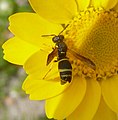Fasciculus:Odynerus spinipes^ Vespidae. See parasite note - Flickr - gailhampshire.jpg

Mensura huius perspectionis: 519 × 600 elementa imaginalia. Aliae mensurae: 208 × 240 elementa imaginalia | 415 × 480 elementa imaginalia | 654 × 756 elementa imaginalia.
Sua resolutio (654 × 756 elementa imaginalia, magnitudo fasciculi: 166 chiliocteti, typus MIME: image/jpeg)
Historia fasciculi
Presso die vel tempore fasciculum videbis, sicut tunc temporis apparuit.
| Dies/Tempus | Minutio | Dimensiones | Usor | Sententia | |
|---|---|---|---|---|---|
| recentissima | 13:21, 14 Octobris 2017 |  | 654 × 756 (166 chiliocteti) | Chiswick Chap | Cropped 31 % horizontally and 22 % vertically using CropTool with precise mode. |
| 21:48, 8 Iulii 2016 |  | 952 × 972 (183 chiliocteti) | Josve05a | == {{int:filedesc}} == {{Information |Description=Most Strepsiptera (also known as twisted-wing parasites) live as internal parasites of bees, wasps, grasshoppers, leafhoppers, and other members of the order Hemiptera. Only a few species that parasit... |
Nexus ad fasciculum
Ad hunc fasciculum nectit:
Usus fasciculi per inceptus Vicimediorum
Quae incepta Vici fasciculo utuntur:
- Usus in en.wikipedia.org
- Usus in fa.wikipedia.org
- Usus in gl.wikipedia.org
- Usus in tr.wikipedia.org
